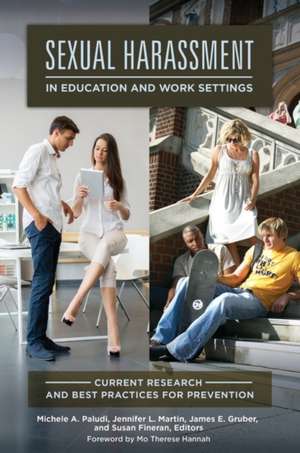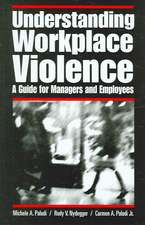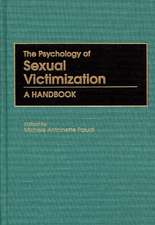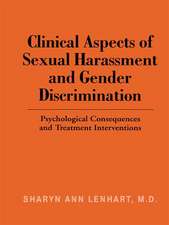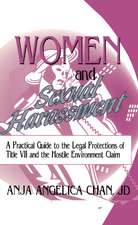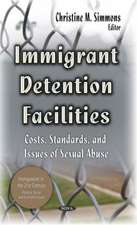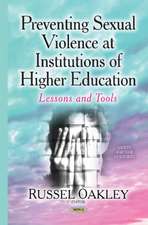Sexual Harassment in Education and Work Settings: Current Research and Best Practices for Prevention: Women's Psychology
Editat de Michele A. Paludi Cuvânt înainte de Mo Therese Hannah Editat de Jennifer L. Martin, James E. Gruber, Susan Fineranen Limba Engleză Hardback – 25 aug 2015 – vârsta până la 17 ani
Din seria Women's Psychology
- 22%
 Preț: 241.04 lei
Preț: 241.04 lei - 14%
 Preț: 308.70 lei
Preț: 308.70 lei - 14%
 Preț: 355.52 lei
Preț: 355.52 lei - 26%
 Preț: 357.89 lei
Preț: 357.89 lei - 14%
 Preț: 310.32 lei
Preț: 310.32 lei - 27%
 Preț: 368.61 lei
Preț: 368.61 lei - 34%
 Preț: 372.00 lei
Preț: 372.00 lei - 37%
 Preț: 355.96 lei
Preț: 355.96 lei - 26%
 Preț: 358.37 lei
Preț: 358.37 lei - 14%
 Preț: 358.85 lei
Preț: 358.85 lei - 37%
 Preț: 350.06 lei
Preț: 350.06 lei - 23%
 Preț: 369.04 lei
Preț: 369.04 lei - 24%
 Preț: 468.36 lei
Preț: 468.36 lei - 34%
 Preț: 469.20 lei
Preț: 469.20 lei - 27%
![The Psychology of Love [4 Volumes]](https://i0.books-express.ro/bs/9780313393150/the-psychology-of-love-4-volumes.jpg) Preț: 1270.56 lei
Preț: 1270.56 lei -

Preț: 442.48 lei
Preț vechi: 710.41 lei
-38% Nou
Puncte Express: 664
Preț estimativ în valută:
84.66€ • 88.41$ • 69.92£
84.66€ • 88.41$ • 69.92£
Carte tipărită la comandă
Livrare economică 15-29 aprilie
Preluare comenzi: 021 569.72.76
Specificații
ISBN-13: 9781440832932
ISBN-10: 1440832935
Pagini: 400
Dimensiuni: 156 x 235 x 28 mm
Greutate: 0.77 kg
Editura: Bloomsbury Publishing
Colecția Praeger
Seria Women's Psychology
Locul publicării:New York, United States
ISBN-10: 1440832935
Pagini: 400
Dimensiuni: 156 x 235 x 28 mm
Greutate: 0.77 kg
Editura: Bloomsbury Publishing
Colecția Praeger
Seria Women's Psychology
Locul publicării:New York, United States
Caracteristici
Offers recommendations for investigating complaints of sexual harassment and other forms of sexual misconduct in organizations and universities
Notă biografică
Michele A. Paludi, PhD, is the series editor for Praeger's Psychology of Women and author of Women, Work, and Family: How Companies Thrive with a 21st-Century Multicultural Workforce.Jennifer L. Martin, PhD, is assistant professor of education at the University of Mount Union and editor of Praeger's Women as Leaders in Education: Succeeding Despite Inequity, Discrimination, and Other Challenges.James E. Gruber, PhD, is an internationally known sociologist and one of the founding members of the International Coalition Against Sexual Harassment.Susan Fineran, PhD, MSW, is professor of social work and women and gender studies at the University of Southern Maine.
Cuprins
Series ForewordMichele A. PaludiForewordMo Therese HannahAcknowledgmentsIntroductionMichele A. PaludiPART I: PREVENTING AND RESPONDING TO SEXUAL HARASSMENT IN EDUCATION AND WORKPLACE SETTINGS: CIVILITY, RESPECT, AND VALUING THE DIGNITY OF ALL INDIVIDUALS1. "Respecting" Our Mission, Core Values, and Strategic Commitments: A Hiring Consideration at St. Bonaventure UniversityF. Edward Coughlin, OFM2. Where Mission Meets Practice: Sexual Violence Prevention, Bystander Intervention Education, and Catholic School Teaching at U.S. Catholic Colleges and UniversitiesJoy Galarneau and Shannon O'NeillPART II: HERITAGE OF TITLE IX AND TITLE VII3. From Explicit Equity to Sports to Sexual Assault to Explicit Subjugation: The True Story Behind Title IX and Women's Ongoing Struggle for Equality in EducationWendy Murphy4. A Problem with the U.S. Legal Definition of Sexual HarassmentSandra Ellenbolt and William E. Schweinle5. GPS for Title IX, the Clery Act, and the Violence Against Women Reauthorization Act: Navigating the Current Legal LandscapeJeffrey J. NolanPART III: SEXUAL HARASSMENT: INCIDENCE AND PSYCHOLOGICAL DIMENSIONS6. Denial, Blame, Betrayal, and the Conspiracy of Silence: Educator Sexual Harassment of K Through 12 StudentsSusan Strauss7. Microaggressions in the Workplace: Recommendations for Best PracticesLindsey Sank Davis, Chassitty Whitman, and Kevin L. Nadal8. Sexual Harassment of Low-Wage Immigrant Workers in the United States: Lessons from EEOC LawsuitsCynthia Deitch9. Preventing and Responding to Sexual Harassment at the University of ZurichBrigitte Tag and Pete Hirsch10. Some Reflections on Gender Equality in Law EnforcementIan P. Lloyd, Jr.11. Sexual Harassment of Teenage Girls: Implications for Reporting Gendered Violence As AdultsMichele A. PaludiPART IV: SEXUAL HARASSMENT OF STUDENTS, EMPLOYEES, AND FACULTY: EDUCATION AND TRAINING AS PREVENTION12. Resistance to Sexual Harassment: Inspiring Girls Through FeminismJennifer L. Martin13. Teaching an Online Course on Sexual Harassment: A Course for Graduate and Undergraduate StudentsSusan Fineran14. Sexual Harassment Training: Effective StrategiesWilliam E. Schweinle and Christopher P. RosemanPART V: SEXUAL HARASSMENT: COMPLAINT RESOLUTION15. From Litigation to Mediation: Sexual Harassment Dispute Resolution in the 21st CenturyPhoebe Morgan16. Protocol for the Standardization of Sexual Harassment Investigations: A Mediational ApproachWilliam T. O'Donohue, Adrian H. Bowers, and Gwendolyn C. Carlson17. Understanding Sexual Harassment Dilemmas: Complaint Management, Investigation Processes, and Workplace ImpactKatie L. PustolkaAppendix A: Street Harassment and StudentsDelaney Rives, Olivia Emigh, Anna Youngmann, and David MoralesAppendix B: OrganizationsAmanda Knipple, Susan Strauss, and Michele A. PaludiAppendix C: Sample Training Program OutlinesMichele A. PaludiIndexAbout the Editors and Contributors
Recenzii
[A]n informative and useful guidebook for multiple constituencies. These constituencies include university administrators and faculty, human resource specialists in nonacademic organizations, and advanced undergraduate and graduate students. In my role as a university faculty member, I found their work to be especially useful for understanding how mission can drive sexual harassment policy in academic organizations and for offering suggestions for teaching students about sexual harassment.
